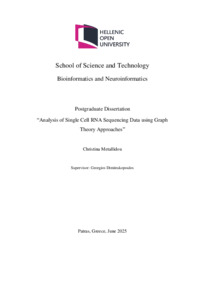- MSc thesis
- Βιοπληροφορική και Νευροπληροφορική (ΒΝΠ)
- 19 July 2025
- Αγγλικά
- 73
- ΔΗΜΗΤΡΑΚΟΠΟΥΛΟΣ ΓΕΩΡΓΙΟΣ
- ΒΛΑΜΟΣ ΠΑΝΑΓΙΩΤΗΣ | ΒΡΑΧΑΤΗΣ ΑΡΙΣΤΕΙΔΗΣ
- Single-cell RNA sequencing | Cancer transcriptomics | Seurat | Differential gene expression | Protein-protein interaction networks | Graph theory
- Βιοπληροφορική και Νευροπληροφορική (ΒΝΠ)/ΒΝΠΔΕ
- 41
-
-
Single-cell RNA sequencing (scRNA-seq) provides unprecedented resolution in analysing gene expression at the individual cellular level, enabling the capture of cellular heterogeneity in complex tissues such as tumours. In this study, single-cell transcriptomic profiles from four distinct cancer types -lung, breast, ovarian, and skin- were analysed using a comprehensive computational workflow based on the Seurat package in the R programming language. The pipeline included quality control, normalization, selection of highly variable genes, dimensionality reduction (via Principal Component Analysis (PCA) and Uniform Manifold Approximation and Projection (UMAP)), clustering, and differential expression analysis. SingleR was applied in conjunction with the Human Primary Cell Atlas to assign biological identity to cell populations, allowing annotation of cells with reference based cell type labels. For each cancer type, differentially expressed genes (DEGs) were identified by comparing transcriptomic profiles of cancer-specific cells to those from other cancer types. Both upregulated and downregulated gene sets were then examined for potential interactions using protein-protein interaction (PPI) networks in Cytoscape. Cytoscape facilitated an in depth understanding of molecular interactions through PPI networks specific to each cancer type, providing visual representations of affected biological processes. Graph theory principles were incorporated to further quantify network structure. Key graph metrics such as node degree, betweenness centrality, and clustering coefficient were calculated to identify hub genes and key regulators within each network. These measurements provided valuable insights into the topological properties of PPI networks, highlighting genes potentially playing central roles in cancer-specific molecular mechanisms. Overall, this integrative approach combining scRNA-seq analysis with graph-based methodologies offers a deeper understanding of gene regulation and protein interaction dynamics across multiple cancer types. This framework supports the identification of novel biomarkers and therapeutic targets, emphasizing the importance of graph-theoretic perspectives in cancer systems biology.
-
- Hellenic Open University
- Αναφορά Δημιουργού-Μη Εμπορική Χρήση 4.0 Διεθνές
Analysis of Single Cell RNA Sequencing Data using Graph Theory Approaches
Ανάλυση Δεδομένων RNA σε Μεμονωμένα Κύτταρα με Προσεγγίσεις Θεωρίας Γραφημάτων (greek)
Main Files
 Metallidou_Christina_MSc_Thesis
Metallidou_Christina_MSc_Thesis
Description: MSc_Thesis_Metallidou_Christina.pdf (pdf) Book Reader
Size: 0.4 MB

